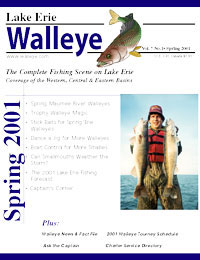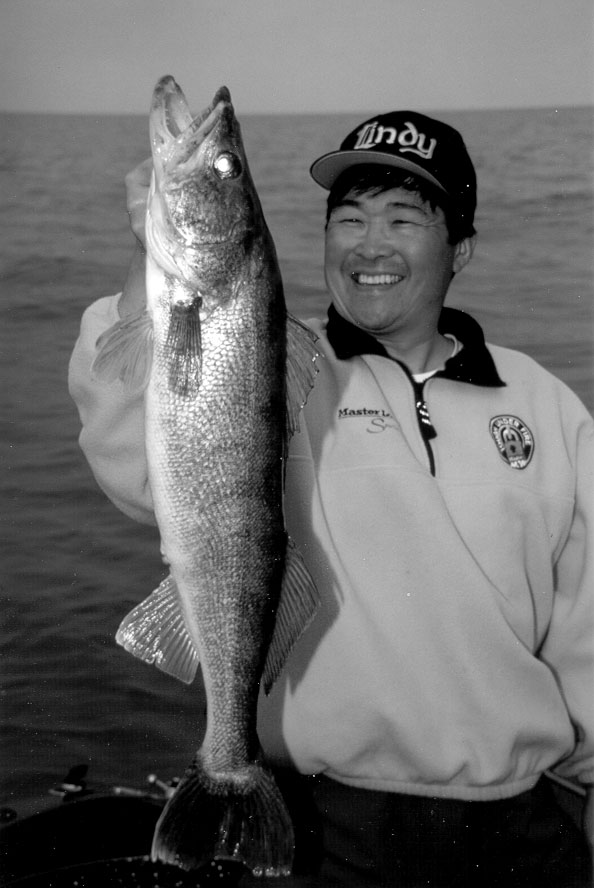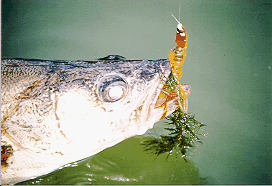Dance a Jig for More
Walleyes
by Ted Takasaki with Scott
Richardson

Order Lake
Erie Walleye Magazine
Three Information-Packed Issues for only $10.00
Delivered to your doorstep every March, June and September
|
Dance a Jig for More
Walleyes
|
|
W
hatís one of the best all-around lures out there? It doesnít matter what species youíre after, what time of year or whether you are fishing a river, lake or reservoir. No game fish is safe. For walleye, it is deadly. "A jig," you say? Right answer. Since the mid 1950s when they first app eared
in tackle shops as the perfect match for that new fangled spinning gear, jigs
have evolved to become one of the most versatile bait delivery system there
is. Let Professional Walleye Trail, jigging master, Daryl Christensen tell you
why.
eared
in tackle shops as the perfect match for that new fangled spinning gear, jigs
have evolved to become one of the most versatile bait delivery system there
is. Let Professional Walleye Trail, jigging master, Daryl Christensen tell you
why.
"I can fish them with a minnow, half a worm or a leech. I can fish a jig in a foot of water or in 30 feet of water. I can fish stumps, weeds, rock, sand, clay, clambeds. I can fish it anywhere.
"I can fish it in July. I can fish it in December. I can fish it from the
bank or from a boat. I can fish them fast or slow. I can fish them vertically.
I can cast horizontally or troll them. I can change sizes from a sixteenth to
an ounce and I only need one medium action rod to do it all.
Thatís why I like jig fishing. You can do so much with a jig that you canít
do with any other kind of presentation."
Jigging basics
Lets start at the beginning. Jigs come in three basic types - round, or ball
jigs; swimming jigs; and current cutters for rivers. Round jigs are best for
vertical jigging tight to drop-offs, humps or points or casting over hard
bottoms. Swimming heads, Christensenís favorites, are great for weeds. Their
eyeletís are positioned toward the front so they are less likely to hang up
than ball jigs with eyeletís on top, and their flatter design makes them
fall slowly so they stay in the strike zone longer.
Current cutters are shaped in a teardrop or oval fashion or come in
keel-weighted varieties. They have their eye on top so they lay ho rizontally
in the water, making them good choices for fishing rivers, trolling flats or
for vertical jigging at depths greater that 5 feet. Shallower than that, cast
to avoid spooking fish. Trolling and drifting jigs are useful search methods
to seek out walleyes.
rizontally
in the water, making them good choices for fishing rivers, trolling flats or
for vertical jigging at depths greater that 5 feet. Shallower than that, cast
to avoid spooking fish. Trolling and drifting jigs are useful search methods
to seek out walleyes.
One thing to remember is that no matter what the choice of jig head style - if you arenít fishing a jig on or near the bottom, you arenít fishing. Itís that simple. Common sense dictates the shallower the fish or the slower the wind or current, the lighter the jig can be. But use a jig heavy enough to maintain bottom contact at all times whether in current, strong winds or deep water.
Boat control techniques can sometimes help you use the lighter jigs. For example, in a river, your boat may move either too fast or too slow to keep slack out of your line while vertical jigging in the current. Compensate by "slipping." Turn your boat into the wind and/or current and use your trolling motor to "chase" your jig.
"But, if you arenít feeling bottom, go heavier," advises Christensen. "Why would you want to use an eighth-ounce jig or even a quarter when even a 12 inch walleye will bite on something bigger? They donít care how big the jig is."
Indeed. Even jumbo jigs shine in the right conditions. Once hard to find in tackle stores, mega jigs like Lindyís new Jumbo Fuzz-E-Grub (comes in two sizes- 5/8ís and 1 ounce) are perfect for jigging deep water, heavy current or fishing upstream. Ever hear of a double jig rig? The system is an effective presentation to use while jigging against current. Tie a jig of an ounce or more to a short dropper line from a three way swivel on the main line. Tie a longer leader to the third eye of the swivel and tie on a floating jig head, a shallow diving crankbait or a plain hook dressed with a minnow, a Fuzz-E-Grub body or both.
Location
Thereís a reason 10 percent of the fishermen catch 90 percent of the fish.
The ones with full live wells fish where the fish are. Use hydrographical
maps, information from guides and bait shops and your own knowledge of walleye
behavior to predict where they will be. Once on the water, nar row
your search with good sonar electronics, like Bottom Lineís Tournament
Champion. It reveals bait fish and walleyes both to the bottom and to the
sides of your boat.
row
your search with good sonar electronics, like Bottom Lineís Tournament
Champion. It reveals bait fish and walleyes both to the bottom and to the
sides of your boat.
Jigs give you pinpoint accuracy. With a transducer on your trolling motor, you can literally drop a jig on a walleyeís nose. And, Christensen notes that jigs let you try spots you might otherwise overlook, like right against the shoreline.
"Youíve got to get tight to shore on those fish. Last year at Lake Winnebago on the second day of the tournament, all my fish came within three feet of shore. I was working a point. Four boats had already fished it deeper and they hadnít caught any fish, thinking that they werenít biting. I came in behind the last boat and took seven fish in eight casts."
"When walleyes are on a shallow bite and they stop, you automatically assume they went out deeper. But sometimes, theyíll go shallower."
Jig Action
Match the action of a jig to fit the walleyesí mood. The most common
presentation for active, scattered walleyes is a simple lift-drop. Let the jig
fall until you feel the bottom or see slack in the line, a signal your jig is
all the way down. Begin reeling and slowly lift your rod tip 3 or 4 inches.
Pause, drop your tip and let the jig touch bottom once again. Repeat.
When casting to aggressive walleyes, let the jig fall to the bottom before popping it a foot or two. Then, let it free fall to the bottom once more trying to keep no slack in the line.
Dragging can be extremely effective when fish are lazy. Lower the jig to the bottom, lower your rod tip and .......
........ to complete this article . For just $10.00/year you'll enjoy all of our latest issue of Lake Erie Walleye magazine. Plus, you'll have online access to past issues of the magazine with hundreds of great articles from the Lake Erie Walleye Magazine Archives!
Lastly, we'll mail this issue plus the next two issues directly to your home.
You can also call our toll free number at 1-800-347-4519 to subscribe today!
drag the jig along while pausing occasionally. Taut line is imperative. Walleyes will most often take the bait on the pause.
Quivering is a variation of dragging used when walleyes are extremely inactive, such as times right after spawning or a cold front. Just drop the jig along the bottom, pause with a little slack line and gently shake your rod tip back and forth. Lift the jig a little. If it feels heavier than it should, set the hook. Slow is the keyword.
Aggressive walleyes will often smack a jig. But just as often they will gently suck it in and swim away. Get in the habit of watching your line. Set the hook anytime you see it twitch or move sideways. Eight pound test Stren Magnathin is probably the best all around jigging line ever made. It has excellent strength and has a thin diameter for good feel and control. Another good idea - countdown the jig so you know when it stops before reaching the bottom. What do you do when it does? Thatís right, set the hook and catch those often overlooked suspended fish.
In addition, Christensen says always, always fish your jig all the way back to the boat. "Many, many times when I am casting a point, Iíll catch one or two fish tight to shore, then Iíll catch five more right next to the boat. They will follow the first ones out. Or, they got spooked and moved out deeper right next to me. You can catch them by vertical jigging."
Best dressed jigs
A few guidelines are helpful when deciding what live bait should go on your
jig. Minnows seem to work best in spring and fall. Nightcrawlers are a good
choice anytime of the year. Use only a half or a third of the nightcrawler.
Leeches are good in water at 55 degrees or above. Colder, and they tend to
ball up and be ineffective.
When it comes to color, brighter ones like chartreuse yellow, lime green or orange, are good in dirty or stained water. Try blues, blacks or purples for clearer water. Change every half hour or so until you find the color that the walleyes are wanting at the time. Christensen uses plastic only to bulk up his presentation to offer a bigger looking bait.
Master this lure for all seasons, anywhere, in any situation, and youíll soon have walleyes dancing a jig - right on the end of you line.